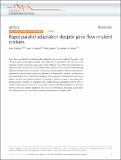Files in this item
Rapid parallel adaptation despite gene flow in silent crickets
Item metadata
| dc.contributor.author | Zhang, Xiao | |
| dc.contributor.author | Rayner, Jack G. | |
| dc.contributor.author | Blaxter, Mark | |
| dc.contributor.author | Bailey, Nathan W. | |
| dc.date.accessioned | 2021-01-12T12:16:19Z | |
| dc.date.available | 2021-01-12T12:16:19Z | |
| dc.date.issued | 2021-01-04 | |
| dc.identifier | 271408187 | |
| dc.identifier | a3a5f259-ad04-4d79-8d5a-7b00196d23c0 | |
| dc.identifier | 85098618258 | |
| dc.identifier | 000665627200026 | |
| dc.identifier.citation | Zhang , X , Rayner , J G , Blaxter , M & Bailey , N W 2021 , ' Rapid parallel adaptation despite gene flow in silent crickets ' , Nature Communications , vol. 12 , 50 . https://doi.org/10.1038/s41467-020-20263-4 | en |
| dc.identifier.issn | 2041-1723 | |
| dc.identifier.other | ORCID: /0000-0003-1996-8313/work/86987217 | |
| dc.identifier.other | ORCID: /0000-0003-3531-7756/work/86987300 | |
| dc.identifier.uri | https://hdl.handle.net/10023/21265 | |
| dc.description | The work was funded by Natural Environment Research Council awards to N.W.B. [NE/I027800/1, NE/L011255/1]. Bioinformatics support was provided by a Wellcome Trust ISSF award [105621/Z/14/Z]. X.Z. was supported by a China Scholarship Council PhD studentship [201703780018]. | en |
| dc.description.abstract | Gene flow is predicted to impede parallel adaptation via de novo mutation, because it can introduce pre-existing adaptive alleles from population to population. We test this using Hawaiian crickets (Teleogryllus oceanicus) in which ‘flatwing’ males that lack sound-producing wing structures recently arose and spread under selection from an acoustically-orienting parasitoid. Morphometric and genetic comparisons identify distinct flatwing phenotypes in populations on three islands, localized to different loci. Nevertheless, we detect strong, recent and ongoing gene flow among the populations. Using genome scans and gene expression analysis we find that parallel evolution of flatwing on different islands is associated with shared genomic hotspots of adaptation that contain the gene doublesex, but the form of selection differs among islands and corresponds to known flatwing demographics in the wild. We thus show how parallel adaptation can occur on contemporary timescales despite gene flow, indicating that it could be less constrained than previously appreciated. | |
| dc.format.extent | 15 | |
| dc.format.extent | 6842524 | |
| dc.language.iso | eng | |
| dc.relation.ispartof | Nature Communications | en |
| dc.subject | QH301 Biology | en |
| dc.subject | DAS | en |
| dc.subject.lcc | QH301 | en |
| dc.title | Rapid parallel adaptation despite gene flow in silent crickets | en |
| dc.type | Journal article | en |
| dc.contributor.sponsor | The Wellcome Trust | en |
| dc.contributor.sponsor | NERC | en |
| dc.contributor.sponsor | NERC | en |
| dc.contributor.sponsor | NERC | en |
| dc.contributor.institution | University of St Andrews. School of Biology | en |
| dc.contributor.institution | University of St Andrews. Centre for Biological Diversity | en |
| dc.contributor.institution | University of St Andrews. St Andrews Bioinformatics Unit | en |
| dc.identifier.doi | 10.1038/s41467-020-20263-4 | |
| dc.description.status | Peer reviewed | en |
| dc.identifier.url | https://www.nature.com/articles/s41467-020-20263-4#Sec27 | en |
| dc.identifier.grantnumber | 105621/Z/14/Z | en |
| dc.identifier.grantnumber | NE/T000619/1 | en |
| dc.identifier.grantnumber | Ne/I027800/1 | en |
| dc.identifier.grantnumber | NE/L011255/1 | en |
This item appears in the following Collection(s)
Items in the St Andrews Research Repository are protected by copyright, with all rights reserved, unless otherwise indicated.

